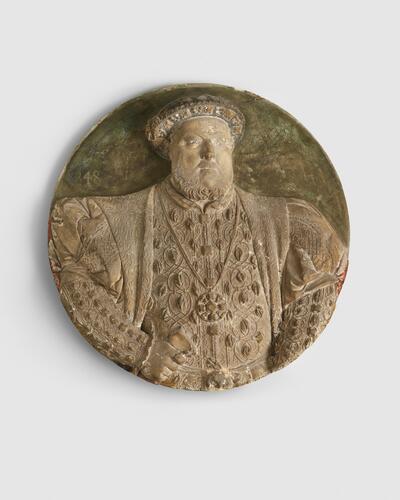Henry VIII early sixteenth century
Stone (honestone) with traces of pigment and gesso, oak frame | 37.5 cm (excluding mounts) | RCIN 1281
-
A carved stone roundel of Henry VIII, half length, facing the front, wearing a jewelled hat with an ostrich plume, an elaborate doublet with slashed ornament, with a sleeveless jacket, a circular pendant around his neck and a glove clasped in his hand. The roundel bears traces of gesso and pigment. The carved oak frame, at one time gilded, is of a later date.
This honestone medallion is undoubtedly based on the numerous portraits of Henry VIII after Holbein's great Whitehall mural of 1537, possibly that now in the Walker Art Gallery, Liverpool. There are particular similarities in the physiognomy of the face and in features such as the folds of the left sleeve (at the shoulder), the pelt folds, the pendant and the bonnet which are relate closely to those in the painting.
The roundel has previously been attributed to the carver Nicholas of Modena who worked for Henry VIII but this attribution is now dismissed. It is more likely that it was made by a German carver or sculptor since honestone is a type of limestone typically found in southern parts of Germany, especially in Bavaria. It was a popular medium, easy to work but durable - high and low relief portraits and compositions in honestone made by German artists of the period are relatively widespread.
The style of this work may have been inspired by Renaissance Florentine terracotta roundels or medallions like the ones made by the Della Robia workshop. This work was originally a polychrome portrait relief, typical of the sixteenth century, and traces of painting and gilding are still visible, especially near the borders. The flat background is painted in dark green.
The roundel has an inscription (number 348) above the left shoulder which possibly relates to an inventory number. It also has white marks which are likely to be traces of a cast of the relief that is thought to have been taken around 1882. The roundel was on loan to the South Kensington Museum (now Victoria & Albert Museum) from 22nd May 1866 until 1882, when Queen Victoria instructed that it should be returned with other objects to Hampton Court Palace, ‘the palace where they belong’. In the instruction there is a request for a mould to be made before being returned.
The roundel is undated but it is thought to have been made in the second half of the sixteenth century. It was possibly commissioned as an ornament, as a historical representation of Henry VIII, a popular character of the period, rather than as a work of propaganda.
In the Abraham Van de Doort’s ‘Catalogue of the Collections of Charles I’, is a entry for a picture of King Henry VIII ‘carved in a greish stone being the peece of king Henry the 8th at length a little intire figure’. This object relates to a rectangular honestone full length relief of Henry VIII which is on loan to the British Museum from a private collection. Although of smaller proportions its style is extremely close to the honestone roundel at Hampton Court. Because of their similarities it is possible that these two pieces were made either by the same artist or by the same workshop. The rectangular full length relief at the British Museum is also unsigned and undated. -
Creator(s)
-
Medium and techniques
Stone (honestone) with traces of pigment and gesso, oak frame
Measurements
37.5 cm (excluding mounts)
47.5 cm (frame, external)
Category
Object type(s)
Bibliographic reference(s)
Holbein and the Court of Henry VIII\ The Queen's Gallery Buckingham Palace Exhibition Catalogue\ 1978-1979 p 137








